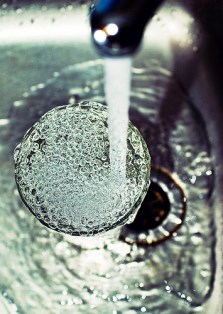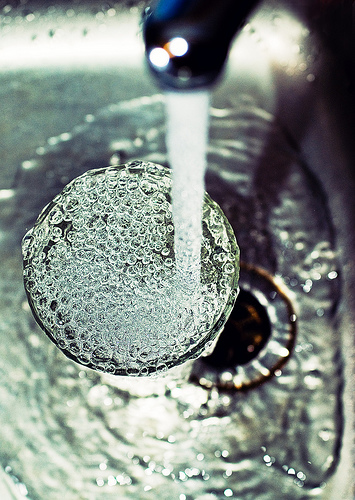
Photo by Anders Andermark.
There is ample evidence that nitrates from synthetic fertilizer pollute the water in California’s farm communities. (We’ve reported on the impact this pollution has on the state’s rural communities here, here, and here). But a new report released by the University of California-Davis proves the problem is much worse than anyone may have suspected.
The report’s scientists measured the nitrate pollution in the water in two parts of California’s Central Valley (the Tulare Lake Basin, which includes Fresno and Bakersfield, and the Salinas Valley). Not surprisingly, it’s an area that’s home to four of the nation’s five biggest farming counties. UC Davis is under contract with the California State Water Resources Control Board to conduct an independent investigation and report on the findings and potential solutions.
The water table in the area is so polluted with nitrates that Thomas Harter, the report’s lead scientist, doesn’t think cleaning it up (or “remediation,” as they say in scientific circles) would be practical.
“Its never been done and it’s hugely costly,” says Harter. “Remediation in the traditional sense has been done at sites that are the size of a football field, and we spend large amounts of money to do that,” he says. Even hypothetically, he adds, bringing the levels of nitrate down to acceptable levels for human consumption “would cost tens of billions of dollars and would take us a long time.”
In the meantime, the report found that at least 2.6 million (or one in 10) people in this region rely on groundwater to drink, and it would cost a full $20 million to $35 million annually to provide them with safe water. Nitrates in water are linked to a number of health issues, including a fatal syndrome in infants called methemoglobinemia, or “blue baby syndrome.”
What’s especially problematic is the fact that nitrate pollution in the Central Valley is likely to get worse before it improves. “For more than half a century, nitrates from fertilizer and animal waste have infiltrated into aquifers,” the report’s executive summary reads. “Most nitrate in drinking water wells today was applied to the surface decades ago.”
Even if agriculture in that area were to stop today, says Harter, ”we’d still see the impact for another 50 years.”
Not that anyone is planning to stop farming in the area, which is why the study points to a lack of clean water for the area’s residents — many of them farmworkers who are living in under-resourced, unincorporated communities — as the most pressing problem.
“Providing safe drinking water is one of the first priorities,” says Harter, who describes the most impacted areas as without city councils, water boards, or the technical capacity to run a water treatment system.
Our N2 addiction
Over 90 percent of the nitrogen that’s leaching into the water comes from some form of agriculture (a combination of manure from Big Dairy and fertilizer from the area’s vegetable farms and fruit orchards, which make up around 40 percent of California’s irrigated cropland).
Synthetic fertilizer is a key ingredient to large-scale conventional agriculture, but it hasn’t always been this way. Farmers once relied on cover crops and manure to release a slow, steady quantity of nitrogen into the soil. Then, a century ago, all that changed when the synthetic form of the stuff — which was more readily available to plants, making them grow faster and produce more food — became widely available.
In a Grist post called “The dark side of nitrogen,” which was part of a 2010 series called the N2 Dilemma, Stephanie Ogburn described the problem:
For the last 50 years, farmers around the world have used synthetic nitrogen fertilizers to boost their crop yields and drive the 20th century’s rapid agricultural intensification…But in their fervor to increase yields, farmers often dose their crops with more nitrogen than the plants can absorb. The excess is now causing serious air and water pollution and threatening human health.
As Harter puts it, “the total amount of nitrogen that is put on the land is about three times as much as we’re actually removing from the land in terms of harvest.” So much for a balanced nitrogen cycle.
Aside from bringing in clean water to those who need it in the affected areas, the study’s authors make a number of recommendations, including taxing farmers in high-polluting areas, and ensuring that the high-nitrate water be used in irrigation (where at least the nitrogen will go to use over time). The study doesn’t mention organic agriculture at all, but it does openly advocate that farmers learn to manage their nitrogen better.
The Tulare Basin and the Salinas Valley can be seen as a kind of a microcosm for today’s agriculture, in the sense that they’re home to a bitter irony: The dairies there create loads of nitrogen-rich manure, which could, in theory, be used in farming (setting aside the presence of antibiotics and hormones for the moment). But most of it ends up as runoff, or collects in lagoons, where it ultimately leaches into the water table — all while conventional farms truck in loads of quick-releasing synthetic fertilizer that is easily taken up by fast-growing row crops.
“The longer-term challenge is to use more of the manure that’s produced in California as a fertilizer,” Harter acknowledged. But he adds that that would require a lot of work to hone what’s called “nutrient management” and — ultimately — would probably not guarantee the same level of speedy production the synthetic stuff does.
The fact is, for as long as industrial-scale farmers can get away with externalizing the cost of the damage this excess nitrogen causes, they probably will.
“What we show in this study is what that externalized cost is: $20 million to $35 million annually to the people we’ve identified as being at risk for nitrates in tap water,” says Harter.
Of course, to the majority of those who buy the food produced in the Tulare Basin and Salinas Valley (it gets shipped all over the country), the impacted communities are about as visible as an underground water table.
But as Verena Radulovic wrote in a recent post for Grist, this lack of visibility doesn’t make the problem any less pronounced. The post reads:
Almost 20 percent of the population lives in poverty and many residents spend up to a fifth of their income on bottled water, which is in addition to the $60 a month they must spend to have contaminated “drinking water” delivered to their home in the first place. In some cases, residents pay an additional $70 monthly water fee for sewage.
“My kids used to get rashes after taking a shower,” relayed Veronica Mendoza, a local resident and activist from Cutler. And even if you don’t break out in welts after bathing, “you are still inhaling the toxins through the steam of the shower,” said Rose Francis, an attorney at CWC. To make matters worse, as Becky noted, many people think that boiling the water will rid it of nitrates when in fact doing so triples the concentration.
Can eaters make a difference by buying food produced on farms that have broken their dependence on synthetic fertilizer? Harter thinks so. “It comes down to educating consumers and giving them a choice about what they eat and buy.” While the report is clearly written about conventional farming and for an audience that doesn’t see organic as a realistic solution to most things, Harter still believes that a core shift in farm practices will be crucial to stopping the pollution from getting worse. “Given the amount of manure we have,” he says, “going organic is going to have to be part of the equation.”




